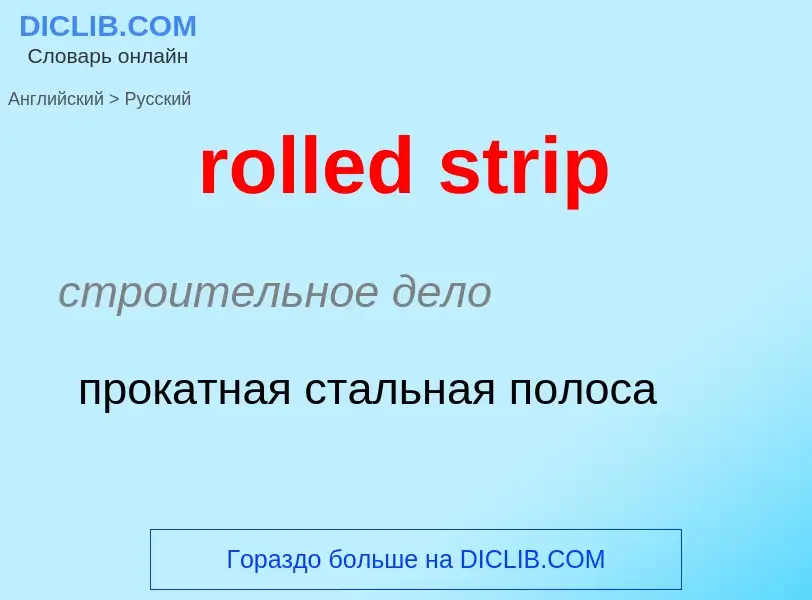Vertaling en analyse van woorden door kunstmatige intelligentie ChatGPT
Op deze pagina kunt u een gedetailleerde analyse krijgen van een woord of zin, geproduceerd met behulp van de beste kunstmatige intelligentietechnologie tot nu toe:
- hoe het woord wordt gebruikt
- gebruiksfrequentie
- het wordt vaker gebruikt in mondelinge of schriftelijke toespraken
- opties voor woordvertaling
- Gebruiksvoorbeelden (meerdere zinnen met vertaling)
- etymologie
rolled strip - vertaling naar russisch
строительное дело
прокатная стальная полоса
[strɪp]
общая лексика
полоса
полоска
выдавливать (икру или молоки)
бандажный
додаивать
магнитная карта
оголять
планка
пластинка
полосовой прокат
полосовый
полосообразный
полотнище
раздевать
слупливать
штрипс
штрипсовый
сокращение
от strip cartoon
строительное дело
лента
рейка
счищать
снимать (слой чего-л.)
электрическая шина
распалубливать, демонтировать опалубку
нефтегазовая промышленность
рейка, планка
геологический разрез скважины
поднимать (бурильную колонну из скважины)
протаскивать (трубы, штанги) сквозь закрытый противовыбросовый превентор
Смотрите также
существительное
[strip]
общая лексика
длинный
узкий кусок
лента
полоска
полоса (земли)
участок
рассказ в картинках (в газете)
аэрофотосъёмочный маршрут
стрип (компьютерный бланк)
длинный узкий кусок
страничка юмора (в газете, журнале)
взлетно-посадочная полоса
порча, разрушение
специальный термин
штрипс
техника
планка
прокладка
полоса
полосовое железо
авиация
взлётно-посадочная полоса
спорт
дорожка (для фехтования)
Смотрите также
глагол
[strip]
общая лексика
резать на длинные
узкие куски
на полоски
на ленты
раздевать
снимать
срывать (одежду)
раздеваться
сдирать
обдирать
счищать
обнажать
сдираться
сниматься
счищаться
(of) лишать (чего-л.)
отбирать (что-л.)
грабить
отнимать
исполнять стриптиз
раздеваться под музыку
разбирать
демонтировать
сдирать, обдирать
лишать (чего-л.)
снимать, срывать
разбирать, демонтировать
техника
срывать резьбу
металлургия
раздевать (слиток)
добыча полезных ископаемых
вскрывать
разрабатывать открытым способом
химия
отгонять лёгкие фракции
сельское хозяйство
трепать (лён или пеньку)
выдаивать до конца
отделять среднюю жилку табака
рыболовство
выдавливать (икру, молоки)
Смотрите также
Definitie
Wikipedia

Rolling is a type of motion that combines rotation (commonly, of an axially symmetric object) and translation of that object with respect to a surface (either one or the other moves), such that, if ideal conditions exist, the two are in contact with each other without sliding.
Rolling where there is no sliding is referred to as pure rolling. By definition, there is no sliding when there is a frame of reference in which all points of contact on the rolling object have the same velocity as their counterparts on the surface on which the object rolls; in particular, for a frame of reference in which the rolling plane is at rest (see animation), the instantaneous velocity of all the points of contact (e.g., a generating line segment of a cylinder) of the rolling object is zero.
In practice, due to small deformations near the contact area, some sliding and energy dissipation occurs. Nevertheless, the resulting rolling resistance is much lower than sliding friction, and thus, rolling objects, typically require much less energy to be moved than sliding ones. As a result, such objects will more easily move, if they experience a force with a component along the surface, for instance gravity on a tilted surface, wind, pushing, pulling, or torque from an engine. Unlike cylindrical axially symmetric objects, the rolling motion of a cone is such that while rolling on a flat surface, its center of gravity performs a circular motion, rather than a linear motion. Rolling objects are not necessarily axially-symmetrical. Two well known non-axially-symmetrical rollers are the Reuleaux triangle and the Meissner bodies. The oloid and the sphericon are members of a special family of developable rollers that develop their entire surface when rolling down a flat plane. Objects with corners, such as dice, roll by successive rotations about the edge or corner which is in contact with the surface. The construction of a specific surface allows even a perfect square wheel to roll with its centroid at constant height above a reference plane.


